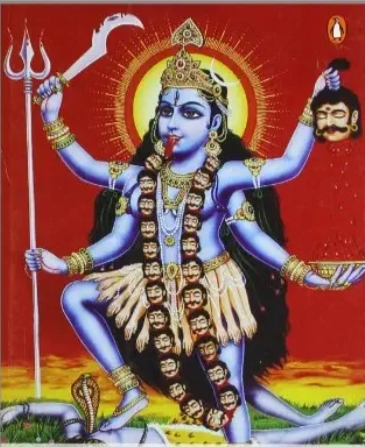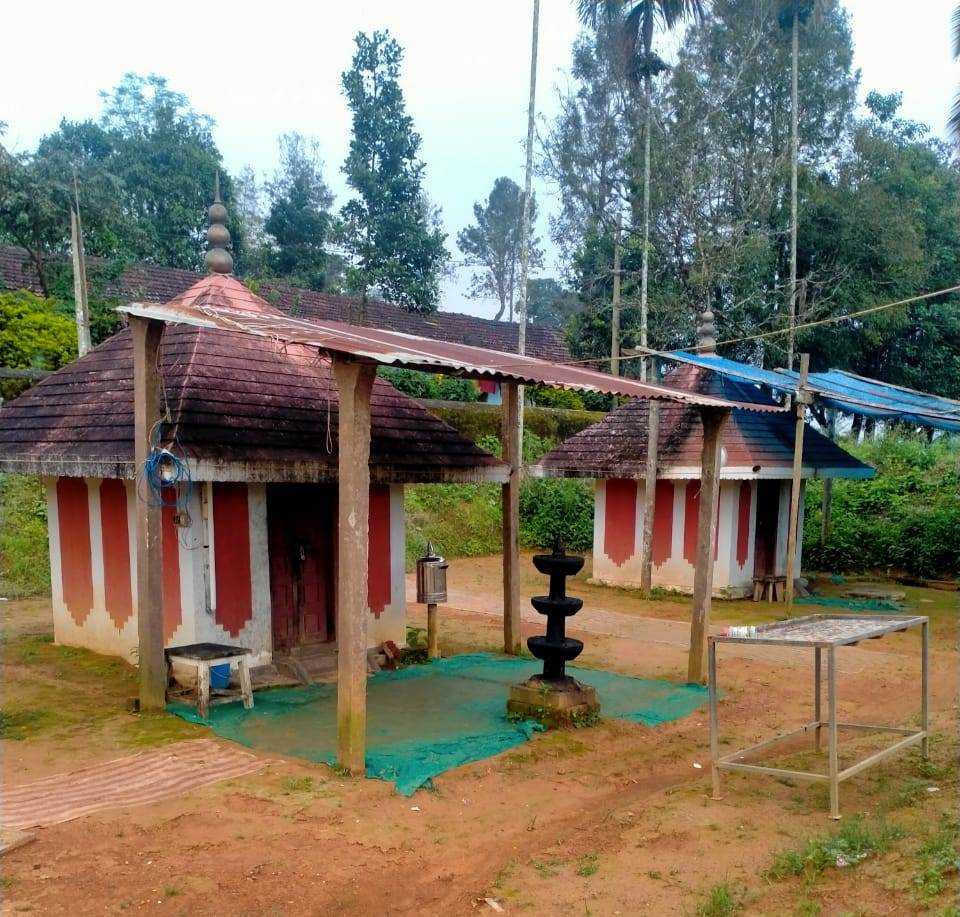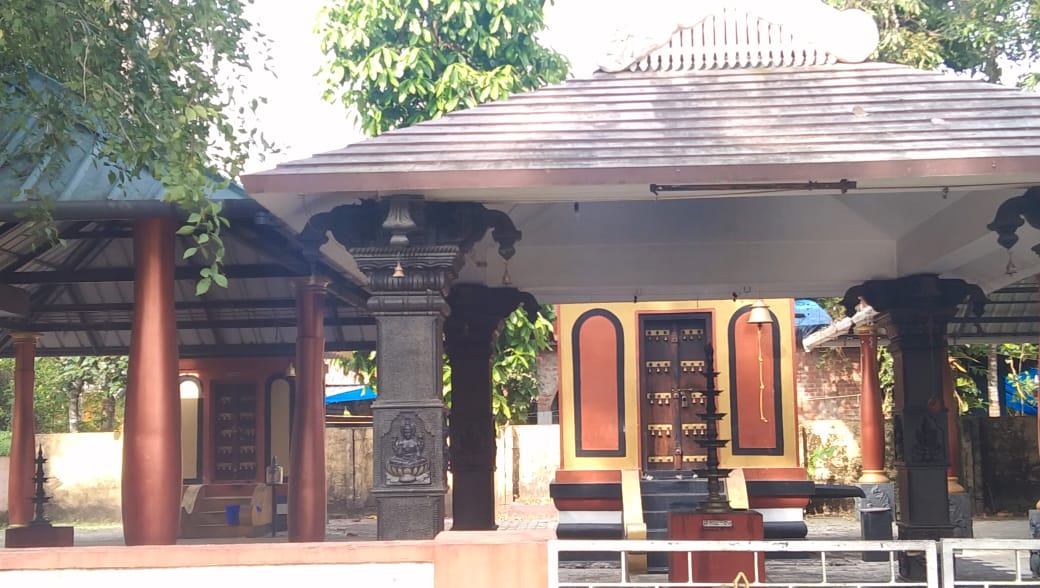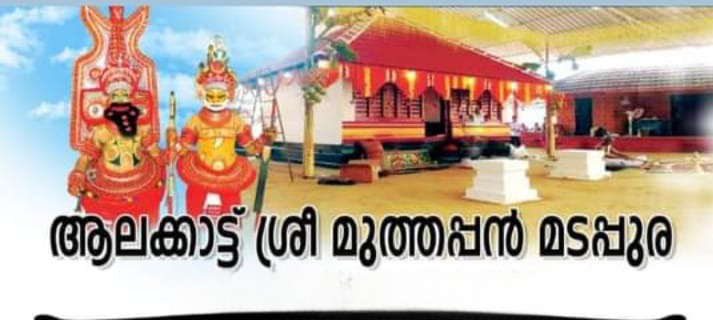Koodalmanikyam is the Malayalam translation of the Sanskrit word Sangameswara. There is, however, another folklore about the name. One day the idol was found to give out uncommon brightness from its forehead. Beaing unable to identify the source of the brightness, some brought a Quartz (Manikyam) in the possession of Raja of Kayamkulam for comparison. As they were comparing the brightness of the two, it is said the stone brought from Kayamkulam mysteriously slipped from the hand and merged with the one on the idol. The merging of the two manikyams led to the name 'Koodalmanikyam'. Similar brightness is reported to have appeared on the idol once again, much later in 1907.
Koodalmanikyam Temple is a marvel in architectural beauty. The impressive gateways, round shaped Sanctum Sactorum, the majestic Koothambalam and the Carvings in wood and stone on the walls all attract students of Art and Architecture. The murals on the walls on either side of the Eastern entry to Chuttambalam also deserve special mention.
The Temple had also been an important centre of nourishment of the Temple Arts like Kathakali, Koothu, Koodiyattom and Thullal. Koothambalam stage had the rare fortune to witness historic stage shows by the masters of Ammannoor Chakyar family. Unnai Warrier, the author of Nalacharitam was a native of Irinjalakuda and an ardent devotee of Sangamewara. He has also composed a Sanskrit poem – Sree Rama Pancha Sathi that is an abridged version of Ramayana in fifty dasakas dedicated to Lord Sangameswara.
The earliest historical reference to Koodalmanikyam Temple is found in a stone inscription attributed to the Chera king Stanu Ravi Varman dated 854 A.D, donating vast extents of land for the Temple. It is, therefore, reasonable to assume that the Temple must have been in existence for quite some time before this date and that even then Koodalmanickyam was occupying a place of importance among the temples of Kerala. Another Cheraman Perumal Bhaskara Ravi Varma has donated vast lands at Potta near Chalakudy to the Temple. The Temple was in the domain of the erstwhile Maharaja of Cochin; but the administration was under a person designated as Thachudaya Kaimal appointed by the Maharaja of Travancore. In 1971, the Government of Kerala, through a special order, took over the administration of the Temple. A Committee appointed from time to time by the Government of Kerala now manages the Temple. The Chairman of the Committee is the District Collector, Thrissur. The Chief Executive of the Devaswom is the Administrator not below the rank of a Deputy Collector deputed by the Government as the Secretary of the Committee.
A straight stretch of 150 meters from Irinjalakuda Municipal Bus Station takes you to the Temple. The eastern gate way (Gopuram) is an impressive structure in the typical Kerala style of architecture with tiled roof and white washed walls. Numerous carvings are embedded into the front wall of the gateway. From the Gopuram you enter the outer quadrangle. The Temple is situated inside a well walled up ten-acre plot with attractive gateways on the East, South and West. The huge porches on the Eastern and Western approach ways to the inner temple can accommodate not less than twenty-one elephants.
The Sanctum Sanctorum is round shaped and is covered with copper plates. A six-foot Thaazhikakudam at the pinnacle adds to the beauty and majesty of the total temple complex. On the Southern courtyard is the well-known Koothambalam, the Natyagruha for Koothu and Koodiyattom.
The temple holds its chief annual festival for ten days each year in the month of Medam (April/May). The first day of the festival is calculated by the appearance of the uthram asterism and signified by hoisting a ceremonial flag (the start day falls one day after the famous Thrissur Pooram festival in nearby Thrissur)
Each day of the festival, a seeveli (procession of caparisoned temple elephants) is held twice, once in the morning and once at night, to the accompaniment of panchari melam (sacred music). Seventeen elephants take part. Two features of the seeveli are unique to the Koodalmanikyam Temple: first that two baby elephants are included in the procession, one standing on each side of the elephant carrying the deity. Second, while the headdresses ('netti pattam' in Malayalam) of seven elephants are made of pure gold, the rest are made of pure silver. The last two days of the festival feature panchavadyam (sacred music from an orchestra of five instruments), and the festival ends at the thiruvonam asterism.
സംഗമേശ്വര എന്ന സംസ്കൃത പദത്തിന്റെ മലയാള പരിഭാഷയാണ് കൂടൽമാണിക്യം. എന്നിരുന്നാലും, പേരിനെക്കുറിച്ച് മറ്റൊരു നാടോടിക്കഥയുണ്ട്. ഒരു ദിവസം വിഗ്രഹം നെറ്റിയിൽ നിന്ന് അസാധാരണമായ തെളിച്ചം പുറപ്പെടുവിക്കുന്നതായി കണ്ടെത്തി. പ്രകാശത്തിന്റെ ഉറവിടം തിരിച്ചറിയാൻ കഴിയാത്തതിനാൽ, ചിലർ താരതമ്യത്തിനായി കായംകുളം രാജയുടെ കൈവശം ഒരു ക്വാർട്സ് (മാണിക്യം) കൊണ്ടുവന്നു. രണ്ടിന്റെയും തെളിച്ചം താരതമ്യപ്പെടുത്തുന്നതിനിടെ കായംകുളത്ത് നിന്ന് കൊണ്ടുവന്ന കല്ല് കൈയ്യിൽ നിന്ന് വഴുതി വിഗ്രഹത്തിൽ ലയിച്ചതായി പറയപ്പെടുന്നു. രണ്ട് മാണിക്യം കൂടിച്ചേർന്നതാണ് 'കൂടൽമാണിക്യം' എന്ന പേരിലേക്ക് നയിച്ചത്. പിന്നീട് 1907-ൽ വീണ്ടും സമാനമായ തെളിച്ചം വിഗ്രഹത്തിൽ പ്രത്യക്ഷപ്പെട്ടതായി റിപ്പോർട്ടുണ്ട്.
കൂടൽമാണിക്യം ക്ഷേത്രം വാസ്തുവിദ്യാ സൗന്ദര്യത്തിൽ ഒരു അത്ഭുതമാണ്. ആകർഷകമായ കവാടങ്ങൾ, വൃത്താകൃതിയിലുള്ള സങ്കേതം, ഗംഭീരമായ കൂത്തമ്പലം, ചുവരുകളിലെ മരത്തിലും കല്ലിലും ഉള്ള കൊത്തുപണികൾ എന്നിവ കലയും വാസ്തുവിദ്യയും പഠിക്കുന്ന വിദ്യാർത്ഥികളെ ആകർഷിക്കുന്നു. ചുറ്റമ്പലത്തിലേക്കുള്ള കിഴക്കേ പ്രവേശനത്തിന്റെ ഇരുവശത്തുമുള്ള ചുമർചിത്രങ്ങളും പ്രത്യേക പരാമർശം അർഹിക്കുന്നു.
കഥകളി, കൂത്ത്, കൂടിയാട്ടം, തുള്ളൽ തുടങ്ങിയ ക്ഷേത്രകലകളുടെ ഒരു പ്രധാന പോഷണ കേന്ദ്രം കൂടിയായിരുന്നു ഈ ക്ഷേത്രം. അമ്മന്നൂർ ചാക്യാർ തറവാട്ടിലെ ആചാര്യന്മാരുടെ ചരിത്രപരമായ സ്റ്റേജ് ഷോകൾക്ക് സാക്ഷ്യം വഹിക്കാനുള്ള അപൂർവ ഭാഗ്യം കൂത്തമ്പലം സ്റ്റേജിന് ലഭിച്ചു. നളചരിതത്തിന്റെ രചയിതാവായ ഉണ്ണായി വാരിയർ ഇരിഞ്ഞാലക്കുട സ്വദേശിയും സംഘമേവരയുടെ കടുത്ത ഭക്തനുമായിരുന്നു. അദ്ദേഹം ഒരു സംസ്കൃത കാവ്യവും രചിച്ചിട്ടുണ്ട് - ശ്രീരാമ പഞ്ച സതി, ഇത് രാമായണത്തിന്റെ സംക്ഷിപ്ത പതിപ്പായ അമ്പത് ദശകങ്ങളിൽ സംഗമേശ്വരന് സമർപ്പിച്ചിരിക്കുന്നു.
കൂടൽമാണിക്യം ക്ഷേത്രത്തെക്കുറിച്ചുള്ള ആദ്യകാല ചരിത്ര പരാമർശം ഇവിടെയുള്ള ഒരു ശിലാശാസനത്തിൽ കാണാം
കൂടൽമാണിക്യം ക്ഷേത്രത്തെക്കുറിച്ചുള്ള ആദ്യകാല ചരിത്രപരമായ പരാമർശം, ചേരരാജാവായ സ്റ്റാനു രവി വർമ്മൻ, എ.ഡി. 854-ൽ, ക്ഷേത്രത്തിനായി വിശാലമായ ഭൂമി ദാനം ചെയ്തതായി ഒരു ശിലാ ലിഖിതത്തിൽ കാണാം. അതിനാൽ, ഈ തീയതിക്ക് മുമ്പുതന്നെ ഈ ക്ഷേത്രം നിലവിലുണ്ടായിരുന്നുവെന്നും അന്നും കൂടൽമാണിക്യത്തിന് കേരളത്തിലെ ക്ഷേത്രങ്ങളിൽ ഒരു പ്രാധാന്യമുണ്ടായിരുന്നുവെന്നും അനുമാനിക്കുന്നത് ന്യായമാണ്. മറ്റൊരു ചേരമാൻ പെരുമാൾ ഭാസ്കര രവിവർമ്മ ക്ഷേത്രത്തിന് ചാലക്കുടിക്കടുത്തുള്ള പോട്ടയിൽ വിശാലമായ ഭൂമി സംഭാവന ചെയ്തിട്ടുണ്ട്. ഈ ക്ഷേത്രം പഴയ കൊച്ചി മഹാരാജാവിന്റെ അധീനതയിലായിരുന്നു. എന്നാൽ ഭരണം തിരുവിതാംകൂർ മഹാരാജാവ് നിയമിച്ച തച്ചുടയ കൈമൾ എന്ന വ്യക്തിയുടെ കീഴിലായിരുന്നു. 1971-ൽ കേരള സർക്കാർ പ്രത്യേക ഉത്തരവിലൂടെ ക്ഷേത്രത്തിന്റെ ഭരണം ഏറ്റെടുത്തു. കേരള സർക്കാർ കാലാകാലങ്ങളിൽ നിയമിക്കുന്ന ഒരു കമ്മിറ്റിയാണ് ഇപ്പോൾ ക്ഷേത്രം കൈകാര്യം ചെയ്യുന്നത്. തൃശൂർ ജില്ലാ കളക്ടറാണ് സമിതിയുടെ ചെയർമാൻ. കമ്മിറ്റിയുടെ സെക്രട്ടറിയായി സർക്കാർ നിയോഗിച്ച ഡെപ്യൂട്ടി കളക്ടർ റാങ്കിൽ കുറയാത്ത അഡ്മിനിസ്ട്രേറ്ററാണ് ദേവസ്വം ചീഫ് എക്സിക്യൂട്ടീവ്.
കിഴക്കേ കവാടം (ഗോപുരം) ടൈൽ പാകിയ മേൽക്കൂരയും വെള്ള കഴുകിയ ചുവരുകളുമുള്ള സാധാരണ കേരള വാസ്തുവിദ്യയിൽ ആകർഷകമായ ഒരു ഘടനയാണ്. ഗേറ്റ്വേയുടെ മുൻവശത്തെ ഭിത്തിയിൽ നിരവധി കൊത്തുപണികൾ പതിഞ്ഞിട്ടുണ്ട്. ഗോപുരത്തിൽ നിന്ന് നിങ്ങൾ പുറത്തെ ചതുർഭുജത്തിലേക്ക് പ്രവേശിക്കുന്നു. കിഴക്ക്, തെക്ക്, പടിഞ്ഞാറ് ഭാഗങ്ങളിൽ ആകർഷകമായ കവാടങ്ങളുള്ള പത്ത് ഏക്കർ പ്ലോട്ടിനുള്ളിലാണ് ക്ഷേത്രം സ്ഥിതി ചെയ്യുന്നത്. കിഴക്കും പടിഞ്ഞാറും അകത്തെ ക്ഷേത്രത്തിലേക്കുള്ള വഴികളിലെ കൂറ്റൻ പൂമുഖങ്ങളിൽ ഇരുപത്തിയൊന്നിൽ കുറയാത്ത ആനകളെ ഉൾക്കൊള്ളാൻ കഴിയും.
വൃത്താകൃതിയിലുള്ള സങ്കേതം ചെമ്പ് തകിടുകൾ കൊണ്ട് മൂടിയിരിക്കുന്നു. മൊത്തത്തിലുള്ള ക്ഷേത്ര സമുച്ചയത്തിന്റെ ഭംഗിയും ഗാംഭീര്യവും വർധിപ്പിക്കുന്നതാണ് ആറടി താഴികക്കുടം. തെക്കേ മുറ്റത്ത് പ്രസിദ്ധമായ കൂത്തമ്പലം, കൂത്തിനും കൂടിയാട്ടത്തിനും നാട്യഗൃഹം.
എല്ലാ വർഷവും മേടമാസത്തിൽ (ഏപ്രിൽ/മേയ്) പത്ത് ദിവസത്തേ വാർഷിക ഉത്സവം നടക്കുന്നു.




No Events for next 2 days